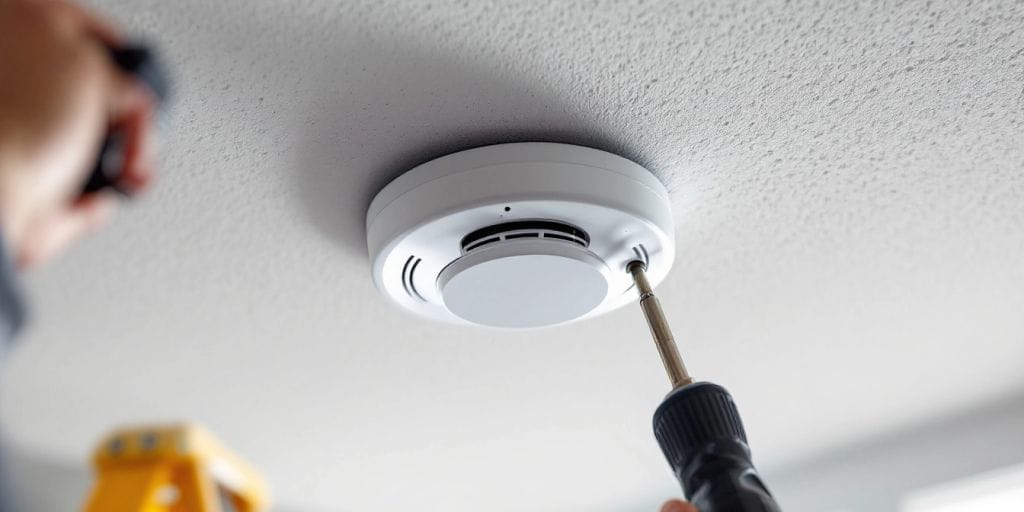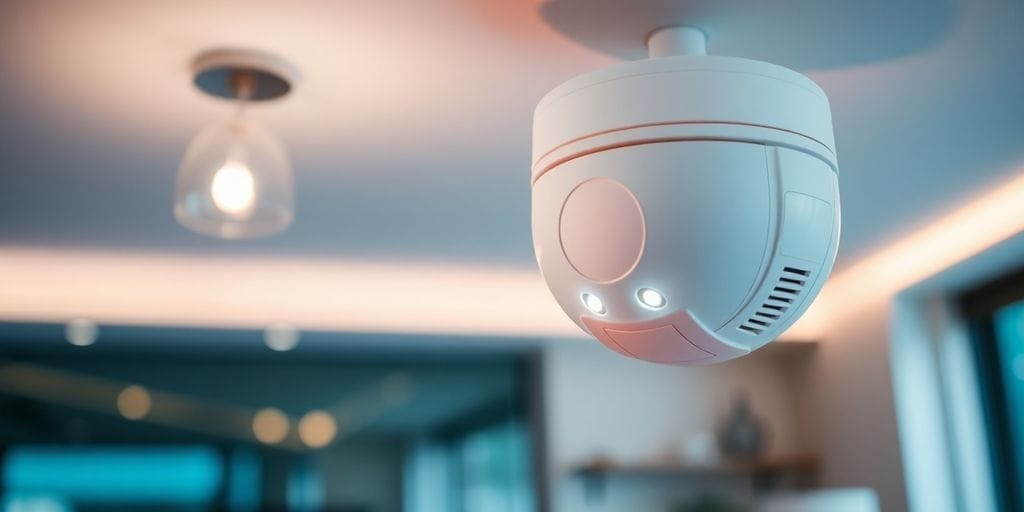
Smoke Alarm Installation and Maintenance is crucial for keeping your home safe from fires. These devices can save lives by providing early warnings, allowing you and your loved ones to escape in time. This guide will help you choose the right smoke alarms, install them correctly, and keep them in good working order.
Key Takeaways
- Choose the right type of smoke alarm for your home, considering factors like battery life and features.
- Install alarms in central locations on every floor, especially near sleeping areas.
- Test your alarms monthly and replace batteries at least once a year.
- Keep smoke alarms clean and dust-free for optimal performance.
- Consider integrating smoke alarms with other safety systems for enhanced protection.
Choosing the Right Smoke Alarm for Your Home
When it comes to fire safety, selecting the right smoke alarm is crucial. There are various types of smoke alarms available, and understanding them can help you make the best choice for your home.
Types of Smoke Alarms
- Ionization Alarms: Best for detecting fast-flaming fires.
- Photoelectric Alarms: More effective for smoldering fires.
- Combination Alarms: These detect both types of fires and are often recommended for comprehensive safety.
Factors to Consider When Buying
- Power Source: Choose between battery-operated or hardwired models.
- Interconnectivity: Look for alarms that can connect with each other for better safety.
- Smart Features: Consider alarms that integrate with your home automation system.
Top Recommended Brands
| Brand | Type of Alarm | Features |
|---|---|---|
| Kidde | Ionization/Photoelectric | Voice alerts, interconnectivity |
| First Alert | Combination | Smart technology, battery backup |
| Nest | Smart | Mobile alerts, integration with other devices |
Choosing the right smoke alarm can be overwhelming, but understanding the different types and features can simplify your decision. Remember, safety comes first!
Proper Placement of Smoke Alarms

Key Locations in Your Home
To ensure safety, smoke alarms should be placed in specific areas:
- Every level of your home, including the basement.
- Inside each bedroom and outside sleeping areas.
- In hallways, especially those longer than 30 feet.
Avoiding Common Placement Mistakes
Here are some common mistakes to avoid:
- Don’t place alarms near windows or ducts; drafts can interfere with their operation.
- Avoid installing them in kitchens or bathrooms to prevent false alarms.
- Ensure alarms are at least 10 feet away from cooking appliances.
Special Considerations for Different Home Layouts
Depending on your home’s layout, consider the following:
- For multi-story homes, place alarms at the bottom of stairwells.
- In homes with pitched roofs, install alarms on the slope, no more than 3 feet from the peak.
- If you have ceiling fans, avoid placing alarms in their path to prevent turbulent air from affecting detection.
Proper placement of smoke alarms is crucial for effective fire safety. Following guidelines can save lives.
Step-by-Step Guide to Installing Smoke Alarms
Tools and Materials Needed
To install smoke alarms, you will need:
- Smoke alarms (battery-operated or hardwired)
- Mounting brackets
- Screws and wall plugs (if necessary)
- Drill and drill bits
- Screwdriver
- Wire nuts (for hardwired models)
- Ladder (if needed)
DIY Installation Tips
- Choose the Right Location: Install smoke alarms on every floor, especially near sleeping areas. Avoid placing them in kitchens to prevent false alarms.
- Mounting the Bracket: Mark the screw holes, drill, and secure the mounting bracket. Ensure it’s stable and flush against the surface.
- Attach the Detector: Align the smoke detector with the bracket and twist or snap it into place.
- Wiring (if applicable): For hardwired models, turn off the power, connect the wires, and secure them with wire nuts.
- Test the Alarm: Press the test button to ensure it works. A loud alarm should sound.
When to Hire a Professional
If you feel unsure about the installation process, especially with hardwired alarms, it’s best to hire a professional. They can ensure everything is set up correctly and safely.
Remember: Regular testing and maintenance of your smoke alarms are crucial for safety. Make it a habit to check them monthly!
Essential Maintenance for Smoke Alarms
Monthly Testing Procedures
To keep your smoke alarms in top shape, testing them every month is crucial. Here’s how to do it:
- Press the test button on each alarm.
- Ensure the alarm sounds loudly.
- If it doesn’t, replace the batteries or the unit.
Annual Battery Replacement
Change the batteries in your smoke alarms at least once a year. A good reminder is to do this on a special date, like the first day of summer. This helps maximize your safety and ensures your alarms are always ready to work.
Cleaning and Dusting Your Alarms
Dust can block smoke from reaching the sensor. Clean your smoke alarms at least once a year:
- Use a vacuum attachment to remove dust.
- Wipe the exterior with a dry cloth.
- Avoid using liquid cleaners.
Regular maintenance of smoke alarms is essential for safety. Keeping them clean and functional can save lives in an emergency.
By following these simple steps, you can ensure that your smoke alarms are always ready to alert you in case of a fire. Remember, a little maintenance goes a long way!
Integrating Smoke Alarms with Other Safety Systems

Connecting to Home Security Systems
Integrating your smoke alarms with your home security system can greatly enhance safety. Here are some key points to consider:
- Central Control Panel: Connect your smoke alarms to the central control panel of your security system. This allows for easier monitoring and management of alerts.
- Synchronization: Ensure that all systems work together. For example, if a smoke alarm goes off, it should trigger the security system to alert the fire department.
- Professional Help: Consult with security professionals to ensure compatibility between your smoke alarms and existing systems.
Smart Smoke Alarms and Home Automation
Smart smoke alarms offer advanced features that can improve safety:
- Real-Time Alerts: Receive notifications on your smartphone if smoke is detected.
- Integration with Other Devices: Smart alarms can work with other smart home devices, like smart locks, to unlock doors automatically during an emergency.
- Battery Backup: Many smart alarms come with a long-lasting battery, ensuring they work even during power outages.
Professional Integration Services
If you’re unsure about how to integrate your smoke alarms, consider hiring professionals:
- Assessment: They will evaluate your current systems and recommend the best integration options.
- Installation: Professionals can ensure that everything is set up correctly and safely.
- Ongoing Support: Many services offer maintenance and support to keep your systems functioning properly.
Integrating smoke alarms with other safety systems is essential for maximizing your home’s safety. Proper integration can save lives and protect property during emergencies.
Common Challenges and Solutions in Smoke Alarm Installation
Dealing with Hard-to-Reach Areas
Installing smoke alarms in hard-to-reach spots can be tricky. Here are some tips to tackle this challenge:
- Use a ladder: Ensure you have a sturdy ladder to reach high ceilings.
- Consider wireless options: Wireless smoke alarms can eliminate the need for complicated wiring.
- Seek help: Don’t hesitate to ask someone for assistance if you’re unsure about your safety while installing.
Preventing False Alarms
False alarms can be annoying and may lead to complacency. To minimize them:
- Avoid kitchen placement: Keep alarms away from cooking areas to prevent false triggers from smoke or steam.
- Use photoelectric alarms: These are less likely to go off due to cooking fumes compared to ionization alarms.
- Regular maintenance: Clean your alarms regularly to prevent dust buildup that can cause false alarms.
Ensuring Compliance with Local Regulations
Following local regulations is crucial for safety. Here’s how to stay compliant:
- Research local codes: Check your local fire department’s guidelines for smoke alarm installation.
- Consult professionals: If unsure, hiring a professional can ensure compliance with all regulations.
- Keep records: Document your installation and maintenance activities to show compliance during inspections.
Regular checks and maintenance of smoke alarms are essential for ensuring they function correctly. Ignoring these can lead to serious safety risks.
Understanding the Importance of Regular Smoke Alarm Checks
Statistics on Smoke Alarm Effectiveness
Regular checks of smoke alarms are crucial for safety. Nearly 60% of fire deaths occur in homes without working smoke alarms. This highlights the need for consistent maintenance and testing. Here are some key statistics:
| Statistic | Percentage |
|---|---|
| Fire deaths in homes without smoke alarms | 60% |
| Home fire deaths in homes with no alarms | 38% |
| Reduction in risk of dying with working alarms | 50% |
Real-Life Case Studies
Many families have shared their experiences regarding smoke alarms. For instance, a family in California had their lives saved because they regularly tested their alarms. They discovered a malfunction during a routine check, which could have led to disaster.
Expert Recommendations for Safety
To ensure your smoke alarms are effective, follow these expert tips:
- Test your alarms monthly to ensure they are functioning properly.
- Replace batteries annually to avoid dead alarms.
- Clean your alarms at least once a year to remove dust and debris that can affect performance.
Regular maintenance of smoke alarms is essential. It helps locate and isolate problems in the system, preventing costly false alarms and ensuring your safety.
By following these guidelines, you can significantly enhance your home’s safety and protect your loved ones from fire hazards.
Final Thoughts on Smoke Alarm Safety
Installing smoke alarms is a key part of keeping your home safe. Make sure to follow the instructions carefully when setting them up. If you feel unsure, it’s best to ask a professional for help. After you install the alarms, test them right away so everyone knows what the sound means. Remember to check them every month and change the batteries once a year. Cleaning them once a year is also important to keep them working well. By taking these steps, you can help protect your family and home from fire dangers.
Frequently Asked Questions
What should I consider when choosing a smoke alarm?
When picking a smoke alarm, think about the type (battery or hardwired), where you’ll place it, and how many you need for your home. Also, check for reliable brands and read reviews.
How often should I test my smoke alarms?
You should test your smoke alarms every month. Press the test button to make sure they work properly.
Where is the best place to install smoke alarms?
Install smoke alarms on every level of your home, especially near bedrooms. They work best on ceilings since smoke rises.
How do I maintain my smoke alarms?
Keep your smoke alarms in good shape by testing them monthly, changing batteries yearly, and cleaning them at least once a year.
Can I install smoke alarms myself?
Yes, you can install smoke alarms yourself if you follow the instructions carefully. However, if you’re unsure, it’s best to hire a professional.
What should I do if my smoke alarm keeps going off?
If your smoke alarm is going off for no reason, check for dust or steam around it. If it continues, it might need to be replaced.






